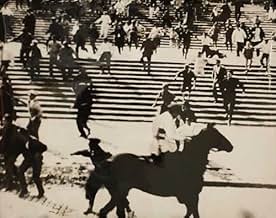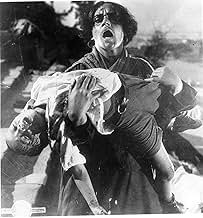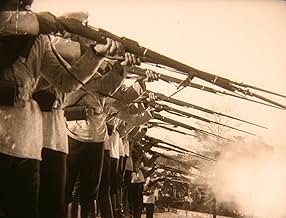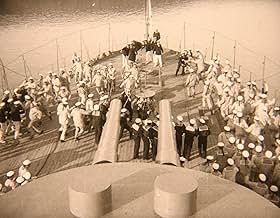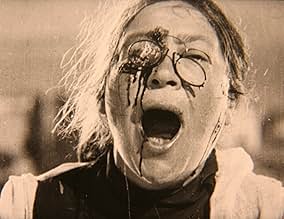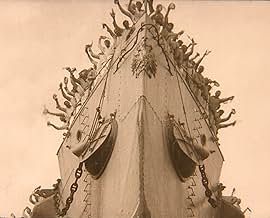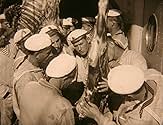Nel mezzo della Rivoluzione Russa del 1905, l'equipaggio della nave da guerra Potemkin si ammutina contro il regime brutale e tirannico degli ufficiali di servizio sulla nave. Ne consegue un... Leggi tuttoNel mezzo della Rivoluzione Russa del 1905, l'equipaggio della nave da guerra Potemkin si ammutina contro il regime brutale e tirannico degli ufficiali di servizio sulla nave. Ne consegue una manifestazione per le strade di Odessa che sfocia in un massacro da parte della polizia.Nel mezzo della Rivoluzione Russa del 1905, l'equipaggio della nave da guerra Potemkin si ammutina contro il regime brutale e tirannico degli ufficiali di servizio sulla nave. Ne consegue una manifestazione per le strade di Odessa che sfocia in un massacro da parte della polizia.
- Regia
- Sceneggiatura
- Star
- Premi
- 1 vittoria in totale
- Young Sailor Flogged While Sleeping
- (as I. Bobrov)
- Woman With Pince-nez
- (as N. Poltavtseva)
- Student
- (as Brodsky)
- Odessa Citizen
- (as Sergei M. Eisenstein)
- Recruit
- (as A. Fait)
Riepilogo
Recensioni in evidenza
The film itself is brimming with shining examples of stunning visual imagery: the spectacles of an overthrown ship captain dangle delicately from the side rope over which he had been tossed; the body of a deceased mutineer lies peaceful upon the shore, the sign on his chest reading "KILLED FOR A BOWL OF SOUP;" close-up shots of the clenching fists of the hundreds of spectators who are finally fed up with the Tsarist regime; a wayward baby carriage careers down the Odessa Steps as desperate onlookers watch on with bated breath (this scene was memorably "borrowed" by Brian De Palma for a particularly suspenseful scene in his 'The Untouchables'); the barrels of numerous canons are ominously leveled towards the vastly-outnumbered battleship Potemkin.
However, the film itself is best analysed not as a fragmented selection of memorable scenes but as a single film, and, indeed, every scene is hugely memorable. Though divided into five fairly-distinct chapters, the entire film flows forwards wonderfully; at no point do we find ourselves losing interest, and we are absolutely never in doubt of whose side we should be sympathetic towards.
The film is often referred to as "propaganda," and that is exactly what it is, but this need not carry a negative connotation. 'The Battleship Potemkin' was produced by Eisenstein with a specific purpose in mind, and it accomplishes this perfectly in every way. Planned by the Soviet Central Committee to coincide with the 20th century celebrations of the unsuccessful 1905 Revolution, 'Potemkin' was predicted to be a popular film in its home country, symbolising the revitalization of Russian arts after the Revolution. It is somewhat unfortunate, then, that Eisenstein's film failed to perform well at the Russian box-office, reportedly beaten by Allan Dwan's 1922 'Robin Hood' film in its opening week and running for just four short weeks. Luckily, despite being banned on various occasions in various countries, 'The Battleship Potemkin' fared more admirably overseas.
The film also proved a successful vehicle for Eisenstein to test his theories of "montage." Through quick-cut editing, and distant shots of the multitudes of extras, the audience is not allowed to sympathise with any individual characters, but with the revolutionary population in general. Eisenstein does briefly break this mould, however, in a scene where Vakulinchuk flees the ship officer who is trying to kill him, and, of course, during the renowned Odessa Steps sequence, as our hearts beat in horror for the life of the unfortunate child in the tumbling baby carriage. The accompanying soundtrack to the version I watched, largely featuring the orchestral works of Dmitri Shostakovich, served wonderfully to heighten the emotional impact of such scenes.
One of the greatest films of the silent era, 'The Battleship Potemkin' is a triumph of phenomenal film-making, and is a significant slice of cinematic history. The highly-exaggerated events of the film (among other things, there was never actually any violent massacre on the Odessa Steps) have so completely engrained themselves in the memory, that we're often uncertain of the true history behind the depicted events. This is a grand achievement.
"Bronenosets Potyomkin" is one of these movies, and it should be on anyone's list looking to learn more about the history of cinema.
Grigori Aleksandrov & Sergei M. Eisenstein directed this groundbreaking film that documents the horrors taking place on a Russian battleship. When the sailors finally retaliate against their superiors, the locals embrace the them, and support them. Things get ugly when a group of soldiers are sent to the small town to take care of business. What follows is one of the most imitated scenes in the history of cinema. Anyone who has seen "The Untouchables", and "Bronenosets Potyomkin" knows exactly what I mean.
Overall I think this movie raised the bar for film making just as "Intolerance" did a few years earlier. If you do not mind silent films, do yourself a favor, and see "Bronenosets Potyomkin".
If you don't like silent films..... watch "Bronenosets Potyomkin" anyway.
Eisenstein was a revolutionary artist, but at the genius level. Not wanting to make a historical drama, Eisenstein used visual texture to give the film a newsreel-look so that the viewer feels he is eavesdropping on a thrilling and politically revolutionary story. This technique is used by Pontecorvo's The Battle of Algiers.
Unlike Pontecorvo, Eisenstein relied on typage, or the casting of non-professionals who had striking physical appearances. The extraordinary faces of the cast are what one remembers from Potemkin. This technique is later used by Frank Capra in Mr. Deeds Goes to Town and Meet John Doe. But in Potemkin, no one individual is cast as a hero or heroine. The story is told through a series of scenes that are combined in a special effect known as montage--the editing and selection of short segments to produce a desired effect on the viewer. D.W. Griffith also used the montage, but no one mastered it so well as Eisenstein.
The artistic filming of the crew sleeping in their hammocks is complemented by the graceful swinging of tables suspended from chains in the galley. In contrast the confrontation between the crew and their officers is charged with electricity and the clenched fists of the masses demonstrate their rage with injustice.
Eisenstein introduced the technique of showing an action and repeating it again but from a slightly different angle to demonstrate intensity. The breaking of a plate bearing the words "Give Us This Day Our Daily Bread" signifies the beginning of the end. This technique is used in Last Year at Marienbad. Also, when the ship's surgeon is tossed over the side, his pince-nez dangles from the rigging. It was these glasses that the officer used to inspect and pass the maggot-infested meat. This sequence ties the punishment to the corruption of the czarist-era.
The most noted sequence in the film, and perhaps in all of film history, is The Odessa Steps. The broad expanse of the steps are filled with hundreds of extras. Rapid and dramatic violence is always suggested and not explicit yet the visual images of the deaths of a few will last in the minds of the viewer forever.
The angular shots of marching boots and legs descending the steps are cleverly accentuated with long menacing shadows from a sun at the top of the steps. The pace of the sequence is deliberately varied between the marching soldiers and a few civilians who summon up courage to beg them to stop. A close up of a woman's face frozen in horror after being struck by a soldier's sword is the direct antecedent of the bank teller in Bonnie in Clyde and gives a lasting impression of the horror of the czarist regime.
The death of a young mother leads to a baby carriage careening down the steps in a sequence that has been copied by Hitchcock in Foreign Correspondent, by Terry Gilliam in Brazil, and Brian DePalma in The Untouchables. This sequence is shown repeatedly from various angles thus drawing out what probably was only a five second event.
Potemkin is a film that immortalizes the revolutionary spirit, celebrates it for those already committed, and propagandizes it for the unconverted. It seethes of fire and roars with the senseless injustices of the decadent czarist regime. Its greatest impact has been on film students who have borrowed and only slightly improved on techniques invented in Russia several generations ago.
Eisenstein had already made a more successful film before this, more reflexively about the seeing eye. So, even though there is a more rip-roaring story here, you may have to struggle a bit with how faceless appears this world to us, these days so accustomed to the paradigm of the individual hero. But Eisenstein was an architect - literally, as well as in film - and so space matters, our relationship with space through motion matters.
In other words; this may have been preserved to us as a museum piece, which is an indictment of our own understanding of cinema as coming down to us by the books and lists of assorted institutions, but at the time it was part of the most deeply revolutionary film school, one that rigged trains as movie studios and sent them scurrying the countryside to film the people and show them to themselves. I mean, here was a man - Eisenstein - who studied Japanese ideograms to understand synthesized image; who discovered that editing to the beats of the human heart affected more, true or false it shows the desire to both know and reach out.
Our cinematic ideas have mostly regressed into mechanical reproduction since the time when these things were first engineered. Oh, there's plenty of Eisenstein every time you open the TV, but none of it is knowing. It's merely a matter of going-through-the-motions, without the blueprint anymore.
So, look at how crowds are orchestrally conducted through stark geometries, how Eisenstein dissects cinematic space with even a stationary camera. But this type of cinema meant to agitate the people, was never about a thought, it was about an action.
And so with this one. There is the one hero who, although dead, calls out to the people. They rush to him, like ships around their harbor. So on board the ship there is valiant effort for brotherhood and justice, inspired revolution; portside is the motherland, cheering the effort with aplomb. And in the end there is the hero ship, itself filled with heroes, now passing through a sea corridor lined with brother ships, all cheering the one. You can imagine the people cheering at the cinema, who had been there to cheer the real thing years ago.
And when I say 'the real thing' I mean the revolution 8 years before; the Potemkin event depicted here was purely fictional. Yet by the famous steps at Odessa is erected a monument to the fictional sailors, what better example of cinema shaping reality?
So yes, it is a revolutionary film. We may be inclined to make fun of the notions, or worse yet dismiss off-hand because of hindsight knowledge. But this was a film celebrating a time when the world seemed like it could be new again. Then came Stalin and, ironically, vanished all these filmmakers that sung the paeans.
It is hard to imagine that anybody who has seen quite a few films in the past few decades would be unaware of this film, but it is perhaps understandable that fewer have had the opportunity to actually sit down and watch. I had never seen this film before but had seen countless references to it in other films and therefore considering it an important film to at least see once. The story is based on real events and this only serves to make it more interesting but even without this context it is still an engaging story. The story doesn't have much in the way of characters but it still brings out the brutality and injustice of events and it is in this that it hooked me surprisingly violent (implied more than modern gore) it demonising the actions and shows innocents falling at all sides in key scenes. The version I saw apparently had the original score (I'm not being snobby modern rescores could be better for all I know) and I felt it worked very well to match and improve the film's mood; dramatic, gentle or exciting, it all works very well.
The feel of the film was a surprise to me because it stood up very well viewed with my modern eyes. At one or two points the model work was very clearly model work but mostly the film is technically impressive. The masses of extras, use of ships and cities and just the way it captures such well organised chaos are all very impressive and would be even done today. What is more impressive with time though is how the film has a very strong and very clean style to it it is not as gritty and flat as many silent films of the period that I have seen; instead it is very crisp and feels very, very professional. Of course watching it in 2004 gives me the benefit of hindsight where I can look back over many films that have referenced the images or directors who have mentioned the film in interviews; but even without this 20:20 vision it is still possible to see how well done the film is and to note how memorable much of it is the steps and the firing squad scenes are two very impressive moments that are very memorable. The only real thing that might bug modern audiences is the acting; it isn't bad but silent acting is very different from acting with sound. Here the actors all over act and rely on their bodies to do much of their delivery word cards just don't do the emotional job so they have to make extra effort to deliver this.
Overall this is a classic film that has influenced many modern directors. The story is engaging and well worth hearing; the directing is crisp and professional, producing many scenes that linger in the memory; the music works to deliver the emotional edge that modern audiences would normally rely on acting and dialogue to deliver and the whole film is over all too quickly! An essential piece of cinema for those that claim to love the media but also a cracking good film in its own right.
Lo sapevi?
- QuizThe flag seen flying on the ship after the crew had mutinied is white, which is the color of the tsars, but this was done so that it could be hand-painted red (the color of communism) on the celluloid. Since this is a black-and-white film, if the flag had been red it would have shown as black in the film. The flag was hand-tinted red for 108 frames by director Sergei Eisenstein for the film's premier.
- BlooperIn the Imperial squadron near the end of the film, there are close-ups of triple gun turrets of Gangut-class dreadnought. It possibly was made this way to show the power of Imperial fleet, but battleships of 1905 were much smaller pre-dreadnoughts, with twin turrets only, just like "Potemkin". "Ganguts" entered service in 1914.
- Versioni alternativeSergei Eisenstein's premiere version opened with an unattributed quote from Leon Trotsky's "1905": The spirit of mutiny swept the land. A tremendous, mysterious process was taking place in countless hearts: the individual personality became dissolved in the mass, and the mass itself became dissolved in the revolutionary impetus. This quote was removed by Soviet censors in 1934, and replaced by a quotation from V.I. Lenin's "Revolutionary Days": Revolution is war. Of all the wars known in history, it is the only lawful, rightful, just and truly great war...In Russia this war has been declared and won. The original text was restored in 2004.
- ConnessioniEdited into Seeds of Freedom (1943)
I più visti
- How long is Battleship Potemkin?Powered by Alexa
Dettagli
- Data di uscita
- Paese di origine
- Lingue
- Celebre anche come
- Battleship Potemkin
- Luoghi delle riprese
- Sevastopol, Crimea, Ucraina(battleship scenes)
- Azienda produttrice
- Vedi altri crediti dell’azienda su IMDbPro
Botteghino
- Lordo Stati Uniti e Canada
- 51.198 USD
- Fine settimana di apertura Stati Uniti e Canada
- 5641 USD
- 16 gen 2011
- Lordo in tutto il mondo
- 70.368 USD
- Tempo di esecuzione
- 1h 15min(75 min)
- Colore
- Mix di suoni
- Proporzioni
- 1.37 : 1


